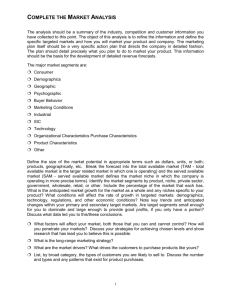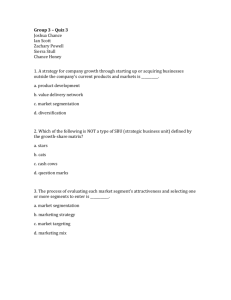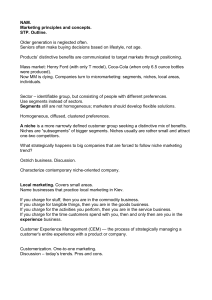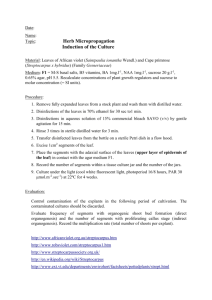Market Analysis Document
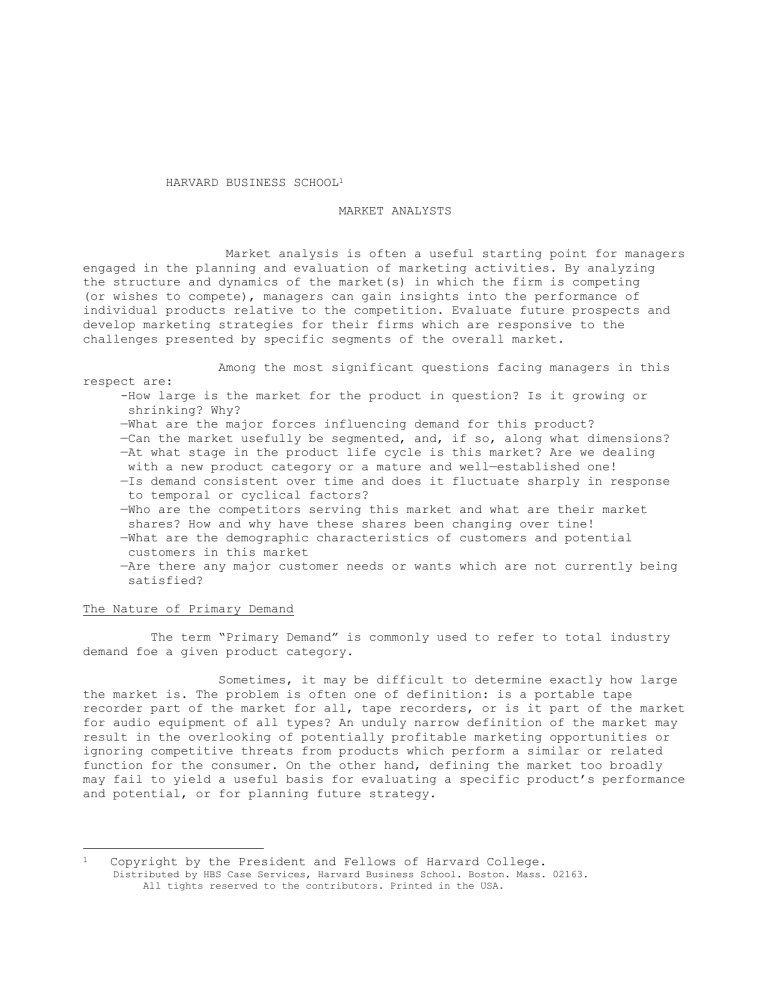
HARVARD BUSINESS SCHOOL 1
MARKET ANALYSTS
Market analysis is often a useful starting point for managers engaged in the planning and evaluation of marketing activities. By analyzing the structure and dynamics of the market(s) in which the firm is competing
(or wishes to compete), managers can gain insights into the performance of individual products relative to the competition. Evaluate future prospects and develop marketing strategies for their firms which are responsive to the challenges presented by specific segments of the overall market.
Among the most significant questions facing managers in this respect are:
-How large is the market for the product in question? Is it growing or shrinking? Why?
—What are the major forces influencing demand for this product?
—Can the market usefully be segmented, and, if so, along what dimensions?
—At what stage in the product life cycle is this market? Are we dealing with a new product category or a mature and well—established one!
—Is demand consistent over time and does it fluctuate sharply in response to temporal or cyclical factors?
—Who are the competitors serving this market and what are their market shares? How and why have these shares been changing over tine!
—What are the demographic characteristics of customers and potential customers in this market
—Are there any major customer needs or wants which are not currently being satisfied?
The Nature of Primary Demand
The term “Primary Demand” is commonly used to refer to total industry demand foe a given product category.
Sometimes, it may be difficult to determine exactly how large the market is. The problem is often one of definition: is a portable tape recorder part of the market for all, tape recorders, or is it part of the market for audio equipment of all types? An unduly narrow definition of the market may result in the overlooking of potentially profitable marketing opportunities or ignoring competitive threats from products which perform a similar or related function for the consumer. On the other hand, defining the market too broadly may fail to yield a useful basis for evaluating a specific product’s performance and potential, or for planning future strategy.
1 Copyright by the President and Fellows of Harvard College.
Distributed by HBS Case Services, Harvard Business School. Boston. Mass. 02163.
All tights reserved to the contributors. Printed in the USA.
Assessing the size of the market may range from a relatively simple task which can be expected to yield quite reliable information to a complex procedure, yielding only approximate “guesstimates.” Many industry statistics are readily available through government statistical publications or are published through trade associations. In other instances, estimates can be purchased from professional research firms (such as Nielsen) which survey sales through a representative sample of retail outlets, or through specially commissioned market studies. Internally—generated estimates may be developed from such sources as trade contacts or sales force reports.
Since market estimates may vary widely in accuracy, it is important to determine the source of the estimate and how the figures were derived in order to evaluate their credibility.
Determinants of Demand
Having obtained some quantitative notion of the size of primary demand, it is desirable to examine the broad trend of demand patterns over time and forecasts for the future. These trends should be reviewed in the light of qualitative or quantitative information, with a view to evaluating the forces which serve to determine demand levels for a particular product category.
Among these determinants may be the level of disposable personal incomes, trends in life styles technological advances, economic expectations, etc. In many instances, the demand for one product is a derivative of the demand for a related one. Thus, the demand for jet aircraft determines the demand for Jet engines; car radio sales are in large measure a function of new automobile production levels; and so forth.
Another - often significant market influence is 1egislation. A change in tire regulations, for instance, may substantially increase primary demand for fire detection devices within the affected g~gaphica1 area, while federal safety legislation has spurred automobile safety b € sales (if not always their usage!).
Market Segmentation
Market segmentation may be defined as the process of dividing the consumer market into meaningful buyer groups and then creating specific marketing programs for one or more of the resulting segments with a view to achieving financial and other corporate objectives. It represents a middle way between a strategy of market aggregation, in which all consumers are treated similarly, and one of total market desegregation. in which each consumer is treated uniquely.
The concept of segmentation is based on the propositions that(1) consumers are different; (2) differences in consumers are related to differences in market behavior; and (3) segments of consumers can be isolated within the overall market. The benefits which may result from a segmentation approach include:
—A more precise definition of the market in terms of the needs of specific groups, why they behave as they do, and possible ways of influencing behavior;
—Improved ability to identify competitive strengths and weaknesses, and opportunities for winning specific segments from the competition;
—More efficient allocation of limited resources to develop programs which can best satisfies the needs of target segments;
—Clarification of objectives and definition of performance standards.
The basic problem is to select segmentation variables which are likely to prove useful in a specific operational context. It can be argued that each of the following three criteria must be satisfied if meaningful market segments are to be developed:
(1) It must be possible to obtain information on the specific characteristics of interest.
(2) Management must be able to identify chosen segments within the
overall market and efficiently focus marketing efforts on these
segments.
(3) The segments must be large enough (and/or sufficiently important
to the organization) to merit the time and cost of separate
attention.
The overall market for any given product can generally be segmented along several different dimensions. Thus, one can segment the market:
(1) geographic any (according to where consumers live or where they
purchase and use the product);
(2) by demographic characteristics of consumers (sex, age, income
levels, stage in the family life—cycle, education level,
occupation, etc.);
(3) by consumption volume or size of unit purchase;
(4) by the different uses to which the product is put;
(5) according to what are termed psychographics (variations in consumers
needs resulting from lifestyle or personality characteristics);
(6) by product attributes (such as size, price range, portability,
technical features, etc.).
It is often useful to segment a market along two or more dimensions at once, but concurrent use of multiple methods of segmentation may lead to an unmanageable and meaningless number of market segments. The same consumer may fall into different segments in different marketing situations. For one product category, the most important variable may be the Consumer’s age, while for others, it may be income level, the purpose for which he or she buys the product, or the type of retail outlet selected.
Selective Demand
The term “selective demand” is used to designate the extent of a given marker being obtained by a particular organization. Considered in relation to pr4n~ary demand, it indicates the market share which a firm may possess or potentially hopes to achieve. If a firm is only competing in a limited number of market segments, it may be more useful to consider market share relative to these segments alone, rather than simply as a percentage of the overall market.
In attempting to increase sales volume, firms are sometimes faced with the choice of seeking, to expand either primary demand or selective demand. If a firm already dominates an existing market (or segment), it may be appropriate
to seek to stimulate consumer demand for that entire product category. As the total market grows, so should that firm’s sales, even if its market share remains constant. - A strategy of stimulating selective demand may be more appropriate when a firm has a relatively small share of a particular market.
Selective demand stimulation involves promotion of brand awareness and preference, with a view to gaining market share from competing brands.
The choice of strategy (and sometimes a hybrid one may be appropriate) should be derived from, careful analysis of market structure and trends. as well as evaluation of competitive strategies.
Stage in Product Life
One factor which may help to determine the potential for stimulating primary demand is the newness or maturity of the product category in question. Most products (other than fashion or fad items) go through a life cycle, beginning with an introductory phase and moving over time through growth, maturity and decline phases to finish with withdrawal from the marketplace. Some, of course, die young.
This lifecycle may be illustrated graphically as follows:
As sales expand, costs and prices typically fall and thus stimulate further growth in sales. accompanied perhaps by added product features and new uses. In time, however, the product may be displaced by net, substitutes or the environment may change and eliminate consumers’ need for this product
Category.
Temporal or Cyclical Variations In Demand
Market demand may not always be consistent over time. The demand for many products is highly seasonal, reflecting climatic variations, cultural or religious customs, or established societal practices such as beginning the school year in the autumn. For this reason, it is important to make seasonal adjustments for comparative purposes and for determining the overall trend of the market.
In other instances, there may be established cyclical variations in demand which, unless identified, can obscure any secular trend in sales.
These fluctuations may be very significant for planning future strategy.
In addition to their implications for production and logistics scheduling, such fluctuations may influence the timing of promotional and selling activities.
Some firms deliberately seek out two or more product lines with counter cyclical demand patterns, so that one is in high demand at tines when others are “out of season.”
Conclusion
This note has highlighted the importance for managers of understanding the structure and dynamics of markets in which they sell, or are considering selling. While qualitative evaluations often provide valuable insights, it is generally also necessary to express market characteristics in quantitative terms for purposes of planning and evaluation.
An understanding of the competitive structure of the market, the characteristics of the distribution channels serving it. and the needs and buying behavior of existing and potential consumers are also important adjuncts to market analysis. Each will be discussed in detail in subsequent notes on competitive analysis, trade analysis and consumer analysis.


